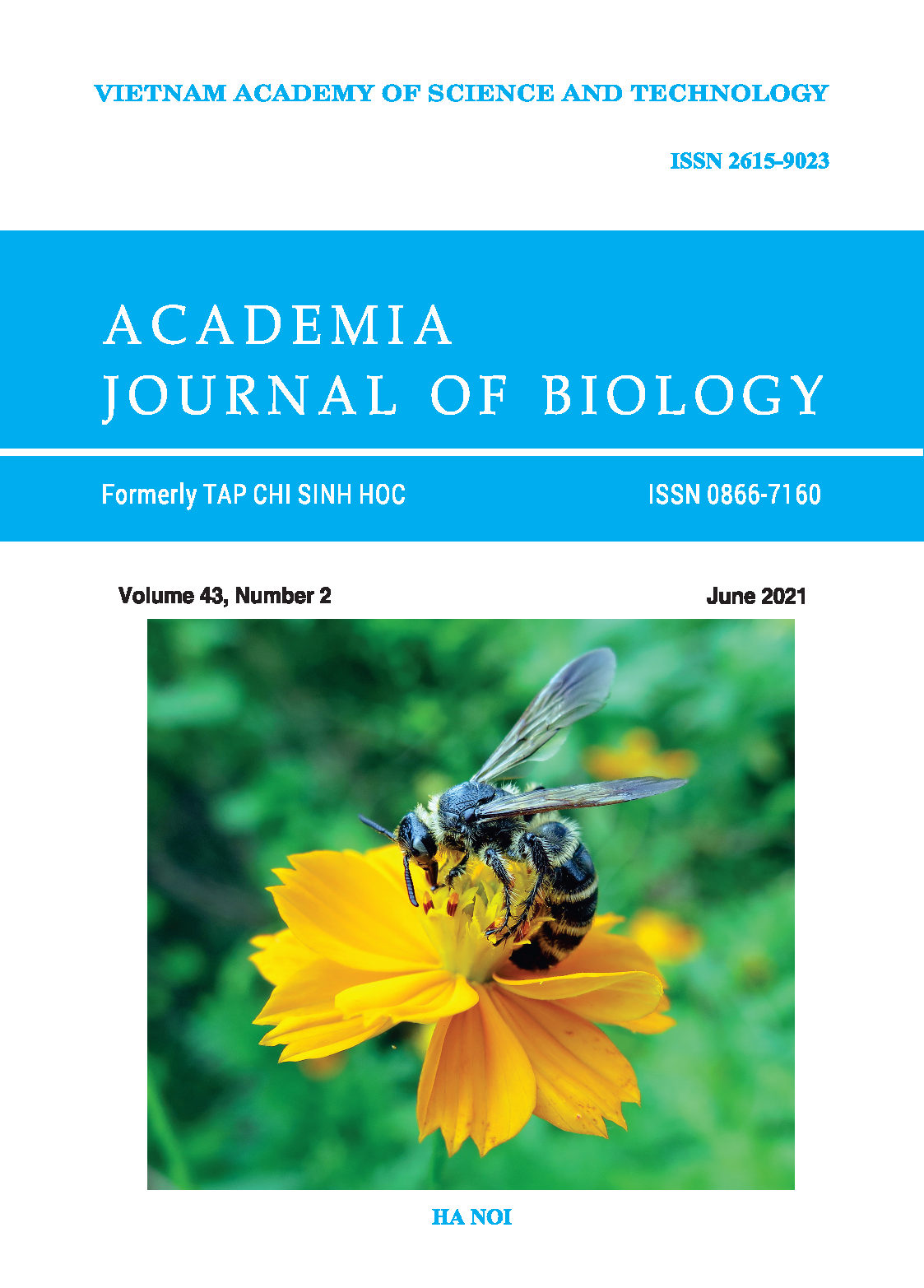Expression of gene coding endoglucanase GH5-4 derived from meagenomic DNA data of bacteria in goats rumen in \(\textit{Escherichia coli}\)
Author affiliations
DOI:
https://doi.org/10.15625/2615-9023/15870Keywords:
CBM, endoglucanase, GH5, goats' rumen, metagenomic DNA dataAbstract
Glycoside Hydrolase family 5 (GH5) members share a broad range of enzymatic activities on oligosaccharides, polysaccharides and glycoconjugates from a wide range of species. The subfamily 4 (GH5-4) is enriched in some broad-specificity endo-β-1,4-endoglucanases (EG). From metagenomic DNA data of bacteria in Vietnam goats' rumen, a gene GL0361920 coding for endoglucanase GH5-4 was mined and selected for expression in Escherichia coli. Firstly, the codons of the gene were optimized and the codon optimized gene (eg3) was artificially synthesized and inserted into pET21a(+) at NdeI-XhoI positions for expression in E. coli. The results of the gene expression in five E. coli strains analyzed by SDS-PAGE showed that the recombinant endoglucanase (EG3) coded by eg3 was the best expressed in BL21, Origami strains, was not expressed in JM109 strain and expressed at very little amount in C43 and Rosetta strains. Among LB, TB, LB, SB, TBD media, the recombinant BL21 strain grew best at TB medium and produced total EG3 higher than the other media. The inducer IPTG gave a negative effect on the growth of the cells but the increase concentration of IPTG from 0.05 mM to 0.9 mM did not increase the negative impact on the cell mass and produced EG3 was nearly the same at the different IPTG concentrations. At 25 oC, in the TB medium containing 0.1 mM IPTG, the recombinant E. coli BL21 strain harboring pET21-eg3 produced about half of endoglucanase EG3 in a soluble form exhibiting activity hydrolyzing CMC substrate. At the OD600=10, soluble EG3 accumulated in the recombinant E. coli BL21 strain had the activity of 0.22 ± 0.006 U/ml.
Downloads
Metrics
References
Asgher M., Ahmad Z., Iqbal H. M.N., 2013. Alkali and enzymatic delignification of sugarcane bagasse to expose cellulose polymers for saccharification and bio-ethanol production. Ind. Crops Prod. 44:488–495. https://doi.org/10.1016/ j.indcrop.2012.10.005
Carriquiry M. A., Du X., Timilsina G. R., 2011. Second generation biofuels: Economics and policies. Energy Policy 39 (7):4222–4234. https://doi.org/10.1016/ j.enpol.2011.04.036
Dash H., Das, S., 2018. Molecular methods for studying microorganisms from atypical environments, 1st ed. Elsevier Ltd. https://doi.org/10.1016/bs.mim. 2018.07.005
De Groot N. S., Ventura S., 2006. Effect of temperature on protein quality in bacterial inclusion bodies. FEBS Lett. 580 (27):6471–6476. https://doi.org/10.1016/ j.febslet.2006.10.071
De Jong E., Higson A., Walsh P., Wellisch M., 2012. Bio-based chemicals: value added products from biorefineries. IEA Bioenergy Task 42 Biorefinery.
Do T. H., Le N. G., Dao T. K., Nguyen T. M. P., Le T. L., Luu H. L., Nguyen K. H. V., Nguyen V. L., Le L. A., Phung T. N., van Straalen N. M., Roelofs D. Truong N. H., 2018. Metagenomic insights into lignocellulose-degrading genes through Illumina-based de novo sequencing of the microbiome in Vietnamese native goats’ rumen. J. Gen. Appl. Microbiol. 64(3): 108–116. https://doi.org/10.2323/ jgam.2017.08.004
Do T. H., Nguyen T. T., Nguyen T. N., Le Q. G., Nguyen C., Kimura K., Truong N. H., 2014. Mining biomass-degrading genes through Illumina-based de novo sequencing and metagenomic analysis of free-living bacteria in the gut of the lower termite Coptotermes gestroi harvested in Vietnam. J. Biosci. Bioeng. 118(6): 665–671. https://doi.org/10.1016/j.jbiosc.2014. 05.010
Duan C. J., Xian L., Zhao G. C., Feng Y., Pang H., Bai X. L., Tang J. L., Ma Q. S., Feng J. X., 2009. Isolation and partial characterization of novel genes encoding acidic cellulases from metagenomes of buffalo rumens. J. Appl. Microbiol. 107(1): 245–256. https://doi.org/10.1111/ j.1365-2672.2009.04202.x
Elifantz H., Waidner L. A., Michelou V. K., Cottrell M. T., Kirchman D. L., 2008. Diversity and abundance of glycosyl hydrolase family 5 in the North Atlantic Ocean. FEMS Microbiol. Ecol. 63(3): 316–327. https://doi.org/10.1111/j.1574-6941.2007.00429.x
Gadgil M., Kapur V., Hu W. S., 2005. Transcriptional response of Escherichia coli to temperature shift. Biotechnol. Prog. 21(3): 689–699. https://doi.org/ 10.1021/bp049630l
Glasgow E. M., Kemna E. I., Bingman C. A., Ing N., Deng K., Bianchetti C. M., Takasuka T. E., Northen T. R., Fox B. G., 2020. A structural and kinetic survey of GH5_4 endoglucanases reveals determinants of broad substrate specificity and opportunities for biomass hydrolysis. J. Biol. Chem. 295(51): 17752–17769. https://doi.org/10.1074/jbc.RA120.015328
Hasan C. M. M., Shimizu K., 2008. Effect of temperature up-shift on fermentation and metabolic characteristics in view of gene expressions in Escherichia coli. Microb. Cell Factories, 7: 35. https://doi.org/ 10.1186/1475-2859-7-35
Hess M., Sczyrba A., Egan R., Kim T. W., Chokhawala H., Schroth G., Luo S., Clark D. S., Chen F., Zhang T., Mackie R. I., Pennacchio L. A., Tringe S. G., Visel A., Woyke T., Wang Z., Rubin E. M., 2011. Metagenomic discovery of biomass-degrading genes and genomes from cow rumen. Science, 331(6016): 463–467. https://doi.org/10.1126/science.1200387
Larentis A. L., Nicolau J. F. M. Q., Esteves G. dos S., Vareschini D. T., de Almeida F. V. R., dos Reis M. G., Galler R., Medeiros M. A., 2014. Evaluation of pre-induction temperature, cell growth at induction and IPTG concentration on the expression of a leptospiral protein in E. coli using shaking flasks and microbioreactor. BMC Res. Notes, 7(1): 671. https://doi.org/10.1186/ 1756-0500-7-671
Lorentz Miller G., 1959. Use of dinitrosalicylic acid reagent for determination of reducing sugar. Anal. Chem., 31(3): 426–428.
Mühlmann M., Forsten E., Noack S., Büchs J., 2017. Optimizing recombinant protein expression via automated induction profiling in microtiter plates at different temperatures. Microb. Cell Factories, 16. https://doi.org/10.1186/s12934-017-0832-4
Ofori-Boateng C., Lee K. T., 2013. Sustainable utilization of oil palm wastes for bioactive phytochemicals for the benefit of the oil palm and nutraceutical industries. Phytochem. Rev. 12(1): 173–190. https://doi.org/10.1007/s11101-013-9270-z
Sørensen H. P., Mortensen K. K., 2005. Soluble expression of recombinant proteins in the cytoplasm of Escherichia coli. Microb. Cell Factories, 4(1): 1. https://doi.org/10.1186/1475-2859-4-1












